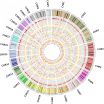(Press-News.org) Cannabis is the most commonly used drug among adults who drink, besides tobacco, yet no study has directly compared those who use cannabis and alcohol simultaneously, or at the exact same time, versus those who use both separately and on a regular basis. A new study looks at the relationship between marijuana and alcohol use, finding that simultaneous users had double the odds of drunk driving, social consequences, and harms to self.
Results will be published in the May 2015 online-only issue of Alcoholism: Clinical & Experimental Research and are currently available at Early View.
"There has been some disagreement regarding whether using cannabis and alcohol together is more dangerous than using either alone," said Meenakshi S. Subbaraman, corresponding author for the study and associate scientist at the Alcohol Research Group, a program of the Public Health Institute. "My study is the first to compare how simultaneous and concurrent use of alcohol and cannabis relate to drunk driving and other social consequences among adults, and the first to examine differences between simultaneous and concurrent users in terms of demographics and substance use quantity/frequency. In this study, concurrent means having used both alcohol and cannabis within the previous 12 months, but always separately."
"Because of both the number of states permitting medical marijuana, and differing legalizations in Washington and Colorado, as well as efforts in other states for legalization, this is a timely study and indeed it is an understudied issue," added Tom Greenfield, center director of the Alcohol Research Group.
The researchers analyzed data from the 2005 and 2010 National Alcohol Survey (n=8,626; 4,522 females, 4,104 males). This was a Random Digit Dial, Computer Assisted Telephone Interview survey of individuals aged 18 and older from all 50 states and DC. Blacks and Hispanics were over-sampled. The study authors assessed differences in demographics, alcohol-related social consequences, harms to self, and drunk driving across simultaneous, concurrent, and alcohol-only using groups.
"We looked at three groups of adults," explained Subbaraman. "One, those who used only alcohol in the previous 12 months; two, those who used both alcohol and cannabis but always separately, or concurrently; and three, those who used both alcohol and cannabis and usually together, or simultaneously. Please note that the simultaneous users did not necessarily always use cannabis while they drank; the groups were based on how often they drank when using cannabis, and not vice versa.
The study authors found that, compared to adults who solely used alcohol, simultaneous users had double the odds of drunk driving, social consequences, and harms to self. Compared to concurrent users, simultaneous users had double the odds of drunk driving. Simultaneous users also had the heaviest drinking patterns in terms of quantity and frequency.
"If cannabis use becomes more prevalent as U.S. states and other countries continue to legalize it, then we need to be prepared to advise people appropriately," cautioned Subbaraman. "If you use both substances together, your risk of drunk driving, and possibly other consequences, may be higher than if you stick to using one at a time."
While Subbaraman acknowledges that few in the field of alcohol studies would be surprised by these findings, she said it was important to study this issue in a scientific way. "Now people have at least one scientifically rigorous, peer-reviewed study to support what they might have already thought they knew," she said. "Most importantly though, the findings will help clinicians and prevention/treatment specialists advise patients and others in the community regarding the elevated risk of consequences related to simultaneous use. I also hope that as the cannabis industry continues to grow, manufacturers will consider some sort of warning label related to increased risks when mixing alcohol and cannabis."
INFORMATION:
Alcoholism: Clinical & Experimental Research (ACER) is the official journal of the Research Society on Alcoholism and the International Society for Biomedical Research on Alcoholism. The co-author of the ACER paper, "Simultaneous vs. concurrent use of alcohol and cannabis in the National Alcohol Survey," was William C. Kerr of the Alcohol Research Group. The study was funded by the National Institute on Alcohol Abuse and Alcoholism.
Contact: Meenakshi S. Subbaraman, Ph.D.
msubbaraman@arg.org
510.597.3440 x285
Alcohol Research Group
Add'l Contact: Tom Greenfield, Ph.D.
tgreenfield@arg.org
510.642.5208
Alcohol Research Group
Alcoholism: Clinical & Experimental Research
WASHINGTON, DC - A new study suggests that an investigational drug for multiple sclerosis (MS) may repair myelin, the fatty material that protects nerves and is damaged in MS, according to a study released today that will be presented at the American Academy of Neurology's 67th Annual Meeting in Washington, DC, April 18 to 25, 2015.
"This study, for the first time, provides biological evidence of repair of damaged myelin in the human brain, and advances the field of neuro-reparative therapies," said study lead author Diego Cadavid, MD, with Biogen in Cambridge, Mass., ...
Divorced women suffer heart attacks at higher rates than women who are continuously married, a new study from Duke Medicine has found. A woman who has been through two or more divorces is nearly twice as likely to have a heart attack when compared to their stably-married female peers, according to the findings.
Even among women who remarry after the stress of divorce, their heart attack risk remains elevated according to the study published in Circulation: Cardiovascular Quality and Outcomes, a journal of the American Heart Association.
"Divorce is a major stressor, ...
New York, NY -- It has been called a pioneering strategy for treating opioid addiction, and has already been adopted in a small yet growing number of jails and prisons in the United States. Now, a clinical trial published in the journal Addiction by researchers at NYU Langone Medical Center finds that the extended-release medication naltrexone (XR-NTX) is associated with a significant decline in relapse rates for a group of mostly heroin-dependent men after their release from New York City jails.
The NYU Langone researchers say that their study is the only randomized ...
New York, April 14, 2015 - Randomized clinical trials of new drugs have long been considered the "gold standard" in determining safety and efficacy before drugs, biologics, vaccines or devices are introduced to the general public. However, in the case of a deadly, rapidly spreading, infectious disease with no known cure, such as Ebola, ethical considerations demand that reliance only on RCTs be reexamined, according to a new Target Article now online and in print in the American Journal of Bioethics.
Authors Arthur Caplan, PhD and Carolyn Plunkett of the Division of ...
Seeking a way to stimulate antitumor responses via the immune system, Steven Fiering, PhD, of Norris Cotton Cancer Center at Dartmouth, has identified the precise temperature that results in a distinct body-wide antitumor immune response that resists metastatic disease. Fiering's team published the research in the paper "Local Hyperthermia Treatment of Tumors Induces CD8+ T Cell-Mediated Resistance Against Distal and Secondary Tumors," which appeared in Nanomedicine: Nanotechnology, Biology and Medicine.
"Mild hyperthermia treatment of an identified tumor, prior to surgery ...
NEW YORK, NY (April 14, 2015) -- The first-ever systematic study of the genomes of patients with ALK-negative anaplastic large cell lymphoma (ALCL), a particularly aggressive form of non-Hodgkin's lymphoma, shows that many cases of the disease are driven by alterations in the JAK/STAT3 cell signaling pathway. The study also demonstrates, in mice implanted with human-derived ALCL tumors, that the disease can be inhibited by compounds that target this pathway, raising hopes that more effective treatments might soon be developed. The study, led by researchers at Columbia University ...
Macrophages destroy bacteria by engulfing them in intracellular compartments, which they then acidify to kill or neutralize the bacteria. However, some pathogenic bacteria, such as Salmonella enterica, have evolved to exist and even grow while within these acidified compartments. Yet, how Salmonella responds to the acidic environment and how that environment affects the virulence of this pathogen are unclear. New research reveals that Salmonella fights acid with acid, by lowering the pH of its own interior in response to the acidification of the Salmonella-containing compartment ...
An unconventional clinical trial design might have advantages over classical trials for testing treatments for Ebola virus disease (EVD), suggests a study published this week in PLOS Medicine. The work of an international team led by John Whitehead of Lancaster University, UK and Ben Cooper of Oxford University, UK, provides much-needed data to inform a debate on the scientific and ethical justification for non-randomized EVD trials that has taken place in the editorial pages of a number of medical journals in past months.
The researchers compared three different scenarios ...
In recent years, research into the benefits of gut bacteria has exploded. Scientists across the globe are examining how these microbes can help improve health and prevent disease.
One of the most well-known of these is Lactobacillus rhamnosus GG (LGG). This strain of bacteria, which is part of many popular probiotic products, has a reputation as a helpful microbe. Researchers have found evidence that it can help with intestinal problems, respiratory infections and some skin disorders. Some research suggests that it may even help with weight loss.
But a key question ...
In research of significance to the world's expanding coastal populations, scientists have found that geology and infrastructure play key roles in determining whether aquifers that provide drinking water are inundated with seawater during a typhoon or hurricane and how long the contamination lasts.
In 2013, Typhoon Haiyan devastated the Philippines, killing more than 6,000 people and destroying nearly $3 billion worth of property. While the country is still recovering from the storm, researchers with The University of Texas at Austin have found that an aquifer on the island ...

